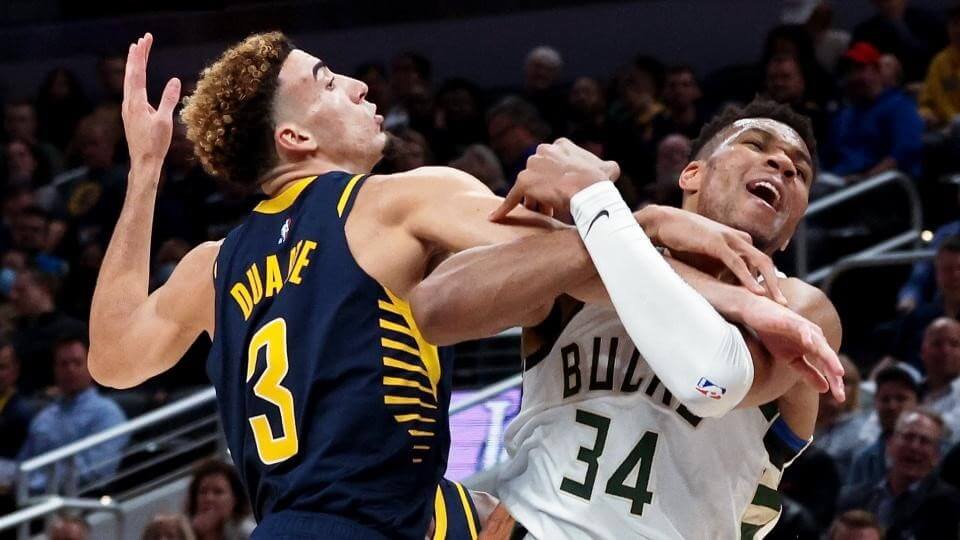What Does PF Mean In Basketball? Simple and Clear Answers
What does PF mean in basketball? If we glance at the score box of a basketball match, we will notice an abundance of abbreviations and acronyms. These numbers are recorded in a basketball match and utilized to assess the whole game’s quality. Although less frequently evaluated than the other numbers, PF is still one of the statistics recorded and noted in every NBA match. However, what does PF mean in basketball? Let’s find out below and see how important PF is.
What Does PF Mean In Basketball?
PF stands for personal fouls in basketball. As we discuss personal fouls, we mean fouls that are recorded for each player on the basketball court. Once a player fouls another, a personal foul can be counted under his PF total in the score box.
The number of personal fouls is a significant factor in basketball. It is because each player is only allowed a certain number of PFs every game.
A player is only allowed six PFs a game according to NBA rules. However, International Basketball Federation (FIBA) regulations allow players to commit a maximum of 5 personal fouls every game.
If a basketball player’s PF total reaches the maximum, he is removed from the game and cannot be played in the exact match again. The PF count is also crucial for the coach since it ensures adequate fouls remain.
According to the basketball rules, the PF count enables the coach to determine whether to make a necessary substitution or keep the player. PF is vital because the number of PFs might influence the player’s aggressiveness. After receiving two PFs, players must reduce their intensity to avoid being removed.

What Are The PF Types In A Basketball Game?
Throughout a basketball match, two personal fouls might occur. These are offensive and defensive fouls, both classified as personal fouls in statistics. Though both are recorded together, they are essential in evaluating how aggressive and rough a player is.
Defensive Fouls
Defensive fouls are the most prevalent in a basketball game. Defenders are more inclined to foul offensive players while attempting to prevent them from scoring by using arms, legs, hands, head, or other parts of the body. Defenders may also foul their opponents when they become overly aggressive on defense.
It is easier to get too physical when performing defense than when playing offensive. Players who commit many defensive fouls are occasionally viewed as physical defenders.
Offensive Fouls
Offensive fouls are far less prevalent, although they still happen in every basketball play. An offensive foul occurs if an offensive player is aggressive against a member of the opposition team.
While a player attempts to go to the goal and score points against his rivals, such as making assists, he may commit an offensive foul. The offensive player may try to force a defender off the ball or gain an unfair advantage, like kicking their leg out while shooting or warding off.
Flagrant fouls are a different kind of foul that is considered excessively rough. It’s worth noting that technical fouls aren’t regarded as personal fouls.
What Is A Personal Foul Example In Basketball?
Regarding personal fouls, they may happen in various ways, whether on defense or offense. A PF is committed when a player strikes, grabs, pushes, trips, or kicks an opponent. Defensive fouls may involve physical contact if a defender fails to take the ball or stop a shot.
Anytime offensive players try to hold the person or push past, they face a personal foul. Offensive fouls can also include charging fouls and illegal screens.
When stepping up for a rebound, regardless of defensive or offensive players, it is frequent to get into a foul. Kicking or hitting another player is a flagrant foul, particularly when the two fight.

How Often Do Personal Fouls Occur In A Basketball Game?
Nowadays, the typical NBA game now has roughly 20 personal fouls for each side. That implies we could witness up to 40 personal fouls during each NBA game! It might seem like much additional time and fouling are added to the basketball game.
However, the total number of fouls has reduced during the game’s history. Because of the shift in playing style, the number of PFs has decreased.
For example, most fouls happen when the ball is within the paint. However, fewer players are getting into the paint to score. We may expect fouls to drop as more players opt to try their luck beyond the area, especially when trying to get Double Double.
Conclusion
What does PF mean in basketball? PF is the abbreviation of personal fouls. While PFs are not the most significant metrics for coaches during a basketball game, they still significantly impact. As the PF count reaches the maximum, the players and coach must make various alterations to their game sports strategy.
FAQs
As defined above, a personal foul is any foul done by an individual player. A team foul refers to the total number of fouls made by the entire team. For example, when two players have four fouls, the team has eight.
In basketball, the term “PF” refers to “personal foul” in stats. However, it can also be “power forward.” One of the five positions on a team is the power forward. It is the most powerful, as the name suggests.
The average NBA game has roughly 20 PFs per team. It implies that each NBA game has around 40 personal fouls. In the past, NBA teams averaged 22 to 23 fouls each game. It means the PFs number has decreased recently.
